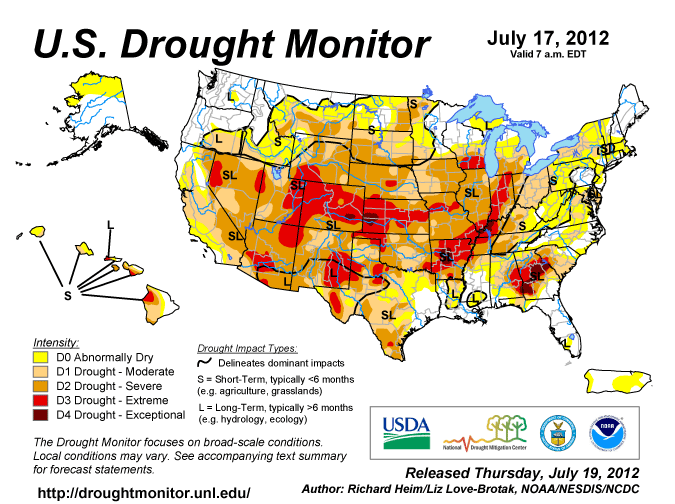We’re in the midst of an epic drought, the worst drought the country has experienced in the last half century. Twenty nine states across the West, Midwest and Great Plains are experiencing drought, according to the U.S. Drought Monitor.
This post is the first in a series on the 2012 Drought in America and highlights its far-reaching impacts on U.S. agriculture. Stay tuned in the coming days as UCS experts on climate science, economics, agriculture, energy and biofuels explore the wide-ranging implications of this historic event.

The U.S. Drought Monitor map shows areas of the U.S. affected by drought as of July 17, 2012. Credit: NOAA/NESDIS/NCDC
Of course, American farmers are on the front lines of the drought’s impacts. But the devastating crop and livestock losses will also translate into enormous costs for U.S. taxpayers and potentially higher global food and feed prices, especially if the drought conditions continue unabated for the next few weeks.
 This is part of a series on the 2012 Drought in America.
This is part of a series on the 2012 Drought in America.
Corn and soybean hit hard
According to USDA’s most recent Crop Progress report, 45 percent of the corn crop across 18 states is in very poor or poor condition and just 26 percent is in good or excellent condition. Similarly, 35 percent of the soybean crop across 18 states is in very poor or poor condition and 31 percent was in good or excellent condition.
This is reflected in the commodities market, with Chicago Board of Trade prices for corn soaring to over $8 a bushel on July 23 (from $6 at the end of June) with projections from Goldman Sachs that it could reach $9 per bushel in three months. Similarly the price of soybean has risen 29 percent since the start of the year, reaching an all-time high of $16.915 on July 23. These prices exceed the highs reached during the 2008 Midwest drought.
Crop insurance losses: Your tax dollars on the hook
The drought of 2012 is also likely to result in record payouts from the federal crop insurance program. This taxpayer-funded program subsidizes insurance for farmers and also partially compensates private insurers, with additional emergency assistance that kicks in during extreme events like the current drought.
Last year, weather-related events led to crop insurance claims of $10.7 billion as of April 30, 2012. According to Bruce Babcock, a professor of economics at Iowa State University, this year’s losses could add up to $30 to $40 billion. Gary Schnitkey, a University of Illinois extension economist, calculates that 2012 insurance payouts for Illinois corn alone could top $3.2 billion.
Livestock losses
The drought has taken a heavy toll on livestock farming. In addition to the impact on feed crops like corn, over half (55 percent) of the pasture and range lands in the country are in poor or very poor condition. Cattle farmers do not have access to the same types of insurance programs as crop farmers so this drought is likely to take a much greater economic toll on them.
Recent news reports indicate that cattle ranchers are selling or liquidating their herds in record numbers because of worsening feed shortages and rising feed prices. This might lead to a temporary glut in the meat market, with lower short-term prices. But by early next year, the longer term impacts of smaller herds and more expensive feed costs will likely lead to higher meat prices.
Impact on global food and feed prices
While the final impact of the drought on 2012 crop yields and prices will not be known until harvest time (which varies from August to November depending on the crop and the state), current projections show that it is likely to be significant.
The U.S. is one of the world’s largest producers of corn and soybean. The drought has hit at a critical time for the development of the crops. We are entering this drought with very little corn or soybean reserves. Additionally, global conditions such as severe heat in corn-growing regions in Europe , a delayed monsoon in India, adverse weather affecting Russia’s wheat crop, dry weather in Australia and a shortfall in the South American soybean harvest will also affect commodity prices. In a future post, I’ll explore more closely how global food and feed prices may be affected by these extreme weather events.
Drought and climate change
The specific factors driving the current drought are still being studied but it is likely that, all else being equal, climate change is increasing the odds of these kinds of hot, dry conditions. Tomorrow UCS climate scientist Brenda Ekwurzel will provide an update on the latest science on climate change and droughts. Meanwhile, take a look at this infographic showing the link between extreme weather and climate change.
Drought response measures
U.S. Agriculture Secretary Tom Vilsack has recently announced a series of emergency steps to help farmers cope with the 2012 drought. While these measures may help in the short run, much more needs to be done to build resilience to these kinds of extreme conditions, including investing in agricultural practices that will be more sustainable in a warming world.
Next week, Doug Gurian-Sherman, a scientist in the UCS Food and Environment program, will write more about ways to reduce the impacts of drought on agriculture and the limits to such adaptation. More fundamentally, events like this highlight why taking action to address climate change is of critical importance to our economic well-being.

